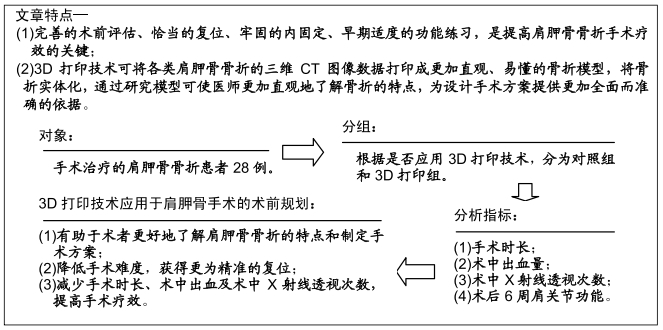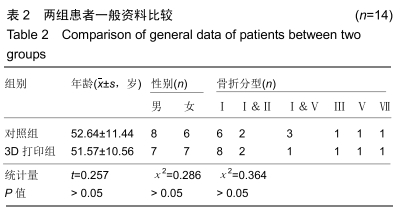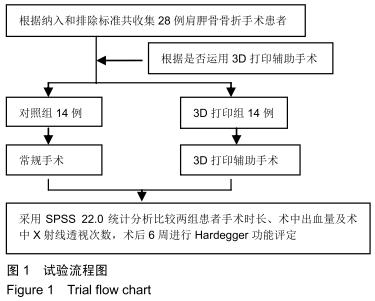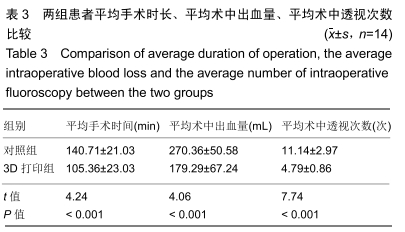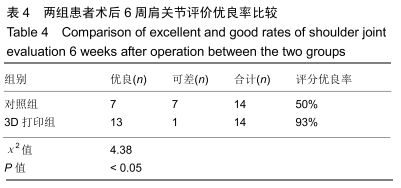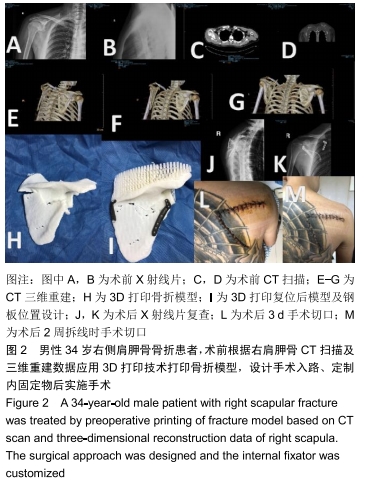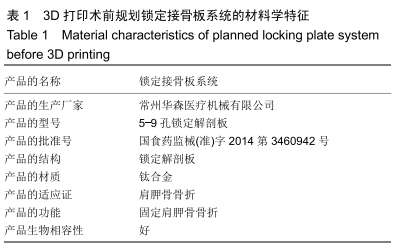[1] DIENSTKNECHT T, HORST K, PISHNAMAZ M, et al. A meta-analysis of operative versus nonoperative treatment in 463 scapular neck fractures. Scand J Surg. 2013;102(2):69-76.
[2] COIMBRA R, CONROY C, TOMINAGA GT, et al. Causes of scapula fractures differ from other shoulder injuries in occupants seriously injured during motor vehicle crashes. Injury. 2010;41(2): 151-155.
[3] 贺强,贾健,张宇.后侧微创入路内固定治疗肩胛骨骨折的临床研究[J].中国修复重建外科杂志,2014,28(7):793-797.
[4] ARAI K, IWANAGA S, TODA H, et al. Three-dimensional inkjet biofabrication based on designed images. Biofabrication. 2011; 3(3):034113.
[5] HARDEGGER FH, SIMPSON LA, WEBER BG. The operative treatment of scapular fractures. J Bone Joint Surg Br.1984;66(5): 725-731.
[6] BARTONÍCEK J, TUCEK M, LUNÁCEK L. Judet posterior approach to the scapula. Acta Chir Orthop Traumatol Cech. 2008;75(6): 429-435.
[7] MILLER ME, ADA JR. Injuries to the shoulder girdle.WB Saunder: Harcourt Publishers Limited,1998:1657-1670.
[8] SCHRODER LK, GAUGER EM, GILBERTSON JA, et al. Functional Outcomes After Operative Management of Extra-Articular Glenoid Neck and Scapular Body Fractures. J Bone Joint Surg Am. 2016; 98(19):1623-1630.
[9] RAMPONI D, WHITE T. Fractures of the Scapula. Adv Emerg Nurs J. 2015;37(3):157-161.
[10] 韦中阳.肩胛骨骨折严重位移的手术治疗分析[J].基层医学论坛, 2016,20(22):3174-3175.
[11] 彭小军,孟春庆,陈伟,等.肩胛骨骨折的分类及微创手术入路的应用疗效分析[J].临床急诊杂志,2013,14(10):481-483.
[12] 孙晓林. 3D打印技术的应用[J].机电产品开发与创新,2013,26(4): 108-109.
[13] 李新春,康麟,庞渊.3D打印技术在Pilon骨折手术治疗中的应用[J].新疆医科大学学报,2015,38(4):472-473.
[14] RENGIER F, MEHNDIRATTA A, VON TENGG-KOBLIGK H, et al. 3D printing based on imaging data: review of medical applications. Int J Comput Assist Radiol Surg. 2010;5(4):335-341.
[15] 焦杰君.3D打印骨折模型定制钢板在复杂骨折中临床应用分析[J].临床医药文献电子杂志,2017,4(31):6004-6005.
[16] 刘应旭,雷大林,朱春冀,等.3D打印骨折模型加定制钢板在复杂骨折中的基础临床应用[J].临床医学研究与实践,2017,2(8):12-13.
[17] 谭叙强,庞彤,程碧,等.电子计算机断层扫描图像三维重建及三维打印在胫骨平台粉碎性骨折的诊断与治疗指导意义[J].中外医学研究, 2015,13(19):64-65.
[18] 王欣文,张堃,朱养均,等.3D打印技术在复杂胫骨平台骨折治疗中的临床应用[J].实用骨科杂志,2015,21(10):887-890.
[19] 邵佳申,常恒瑞,郑占乐,等.3D打印辅助手术治疗胫骨平台骨折疗效的Meta分析[J].中国组织工程研究,2017,21(23):3767-3772.
[20] 李祥,冯辰栋,王林,等.3D打印多孔钛/壳聚糖/羟基磷灰石复合支架的制备与体外生物相容性研究[J].中华创伤骨科杂志,2016,18(1): 6-10.
[21] INZANA JA, OLVERA D, FULLER SM, et al. 3D printing of composite calcium phosphate and collagen scaffolds for bone regeneration. Biomaterials. 2014;35(13):4026-4034.
[22] 阳宏奇,雷青,蔡立宏,等.3D打印导板辅助空心螺钉内固定治疗不稳定性骨盆骨折[J].中国修复重建外科杂志,2018,32(2):145-151.
[23] 张洪涛,孔祥雪,史强,等.3D打印个体化导板在下肢成角畸形螺钉植入中的应用[J].实用骨科杂志,2016,22(5):467-469.
[24] 张海荣,鱼泳.3D打印技术在医学领域的应用[J].医疗卫生装备,2015, 36(3):118-120.
[25] PATTERSON JM, GALATZ L, STREUBEL PN, et al. CT evaluation of extra-articular glenoid neck fractures: does the glenoid medialize or does the scapula lateralize. J Orthop Trauma. 2012;26(6):360-363.
[26] 于鹤童,马占备,马良,等.肩胛骨骨折手术治疗的效果研究[J].中国医药导刊,2017,19(1):45-46.
[27] 赵毅雷,袁即山,章洪喜,等.多发伤中肩胛骨骨折的手术疗效分析[J].中国矫形外科杂志,2015,23(24):2300-2302.
[28] Panigrahi R, Madharia D, Das DS, et al. Outcome Analysis of Intra-Articular Scapula Fracture Fixation with Distal Radius Plate: A Multicenter Prospective Study. Arch Trauma Res. 2016;5(4): e36406.
[29] 吴晓红.肩胛骨骨折的手术治疗与护理[J].按摩与康复医学,2012, 3(6):115-116.
[30] 卢冰,鲜爱明,刘攀,等.3D打印技术在复杂肩胛骨骨折修复术中的辅助应用[J].中国骨与关节杂志,2017,6(5):340-344.
[31] 彭小军,孟春庆,陈伟,等.肩胛骨骨折的分类及微创手术入路的应用疗效分析[J].临床急诊杂志,2013,14(10):481-483.
|
